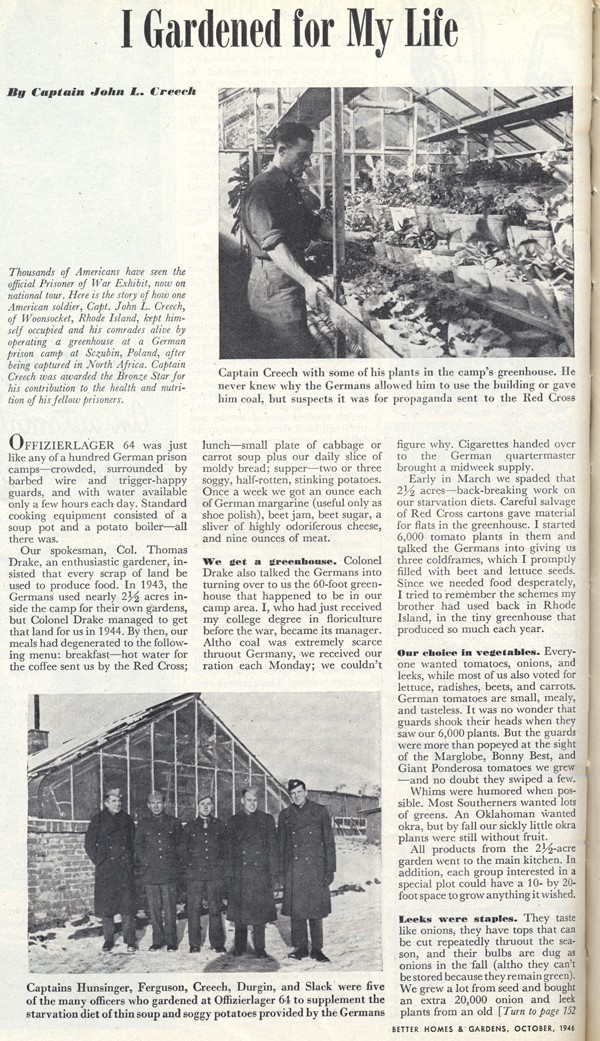Have you ever watched Band of Brothers? Now, that is a show you won’t soon forget. I also recently watched All the Light We Cannot See. (Which is one of those stories that is way better as a book… but watchable in a miniseries). In both, you can see how making a garden in such difficult times would be more than just a way to cultivate beauty, food, and resources or manage stress. It strikes me that gardening under these circumstances becomes an anchor to times with some normalcy. A reminder that planting a seed and cultivating it will work – even with bombs dropping all around and through occupations or when in foreign or hostile lands. The stories of POW gardens and specifically the story of Captain Creech gardening to keep himself and his fellow prisoners alive in a German prison camp in Poland during WWII.
I gardened for my Life – the Gardens of POWs (Prisoners of War)

The American POWs recalled memories of growing plants in Rhode Island to apply to their crop of over 6000 tomato plants and countless other flowers and vegetables. The seeds were donated by the American Red Cross, The Royal Horticultural Society, and from swiping from gardens in the village during the occasional walks granted to Doctors in the camp.
I’ve re-typed (in case you can’t read it) the opening paragraph of this article originally printed in Better Homes and Gardens in October 1944:
Thousands of Americans have seen the Prisoner of War Exhibit now on national tour. Here is the story of how one American soldier, Capt. John L Creech of Woonsocket, RI kept himself occupied and his comrades alive by operating a greenhouse at a German prison camp at Sczubin, Poland, after being captured in North Africa. Capt. Creech was awarded a Bronze star for his contribution to the health and nutrition of his fellow prisoners.
-Better Homes and Gardens October 1944
I found this article on author Kenneth Helphand’s website Defiant Gardens, which I learned about on a visit to the Therapeutic Landscapes Network.
Somehow, I lost sight of the fact that today is Veterans Day. (Srsy, the kids are home from school, and why???Duh.) But this brought me right back and reminded me that tonight at dinner, we will have a toast (or a moment of silence) for all Veterans. And especially to my father-in-law, whom we will be with on Thanksgiving day for his 89th birthday. As a tail gunner, he crash-landed on a French Beach on D-day and survived to tell the story.
In his retirement, he has traveled extensively and is deservedly on a 6-week cruise that started in South Africa and ends next week in Thailand. (Or somewhere near there – the port of call list was mind-boggling, and I can’t keep it straight). We can’t wait for our visit to California to hear about their most recent adventure and to celebrate what continues to be a long and cherished life.
Happy Veteran’s Day!

On another note, I am fascinated by the subject of Kenneth Helphand’s book Defiant Gardens. It is full of stories and research about gardens made in wartime.
Kenneth Helphand describes his subject:
Defiant gardens are gardens created in extreme or difficult environmental, social, political, economic, or cultural conditions. These gardens represent adaptation to challenging circumstances, but they can also be viewed from other dimensions as sites of assertion and affirmation.
There are many kinds of defiant gardens, but my focus is on a selection of those related to war in the first half of the twentieth century:
- gardens of World War I, built behind the lines of the Western front
- gardens built in the Warsaw and other ghettos under the Nazis during World War II
- gardens created in Europe and Asia by prisoners of war and civilian internees in both world wars
- gardens constructed by Japanese American internees in U.S. internment camps during World War II

You can buy Defiant Gardens: Making Gardens in Wartime here.
I was lucky to go to a lecture by Kenneth Helphand a few years ago — his presentation was really really interesting. And Defiant Gardens is an amazing book. So many great stories and examples of perseverance in unbelievably difficult situations. I definitely recommend it, too!